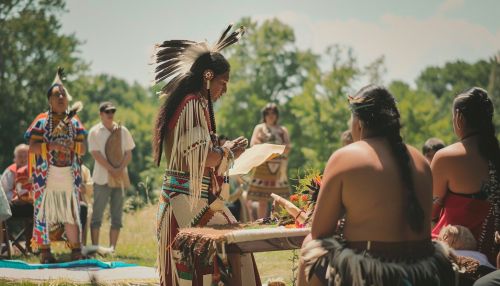Ojibwe language
Introduction
The Ojibwe language, also known as Anishinaabemowin, is a member of the Algonquian language family. It is spoken by the Ojibwe people, one of the largest Indigenous groups in North America, primarily located in Canada and the United States. The language is known for its complex verb morphology and polysynthetic structure, which allows for the creation of long words that convey detailed information.
Historical Context
The Ojibwe language has a rich history that dates back thousands of years. It has been passed down through generations primarily via oral tradition. The arrival of European settlers and subsequent colonization had a significant impact on the language, leading to a decline in the number of fluent speakers. However, recent revitalization efforts have aimed to preserve and promote the use of Ojibwe.
Phonology
Ojibwe phonology is characterized by a relatively small inventory of consonants and vowels. The language includes both short and long vowels, which can change the meaning of words. Consonants include stops, fricatives, nasals, and approximants. The language also features a pitch accent system, which can affect the meaning of words.
Morphology
Ojibwe is a polysynthetic language, meaning that words are often composed of multiple morphemes that convey a range of grammatical information. Verbs are particularly complex, incorporating information about tense, aspect, mood, person, number, and sometimes even location. Nouns are classified into animate and inanimate categories, which affect their grammatical behavior.
Syntax
The syntax of Ojibwe is relatively flexible, allowing for various word orders. However, the most common word order is Subject-Object-Verb (SOV). The language uses a system of obviation to distinguish between different third-person referents in a sentence, which helps to clarify meaning.
Dialects
There are several dialects of Ojibwe, including Southwestern Ojibwe, Northwestern Ojibwe, and Severn Ojibwe. Each dialect has its own unique features, but they are generally mutually intelligible. The differences can include variations in pronunciation, vocabulary, and certain grammatical structures.
Writing Systems
Ojibwe has been written using various orthographies. The most widely used systems are the Double Vowel system and the Algonquian syllabics. The Double Vowel system uses the Latin alphabet and is designed to be phonetic, making it easier for learners. The Algonquian syllabics are a set of characters that represent syllables rather than individual sounds.
Revitalization Efforts
In recent years, there has been a growing movement to revitalize the Ojibwe language. Efforts include the creation of language immersion schools, community classes, and online resources. These initiatives aim to increase the number of fluent speakers and ensure that the language is passed on to future generations.
Cultural Significance
The Ojibwe language is deeply intertwined with the culture and identity of the Ojibwe people. It is used in traditional ceremonies, storytelling, and songs. The language also contains a wealth of knowledge about the natural world, including the names and uses of various plants and animals.
Challenges and Future Prospects
Despite revitalization efforts, the Ojibwe language faces significant challenges. These include a lack of fluent speakers, limited resources, and the dominance of English in many communities. However, the dedication of community members and the increasing availability of educational materials offer hope for the future of the language.
See Also
- Algonquian languages
- Polysynthetic language
- Language revitalization
- Indigenous languages of the Americas
- Ojibwe people


